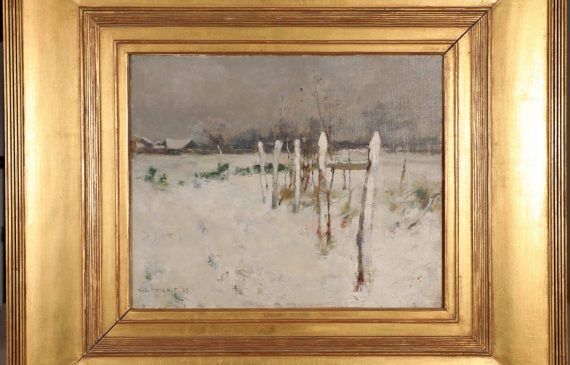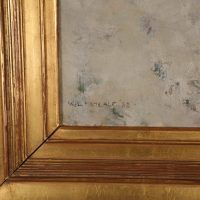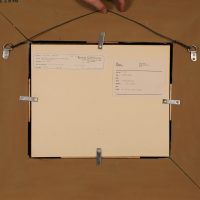


Willard Leroy Metcalf
American, 1858 – 1925
The First Snow, 1888
Oil on canvas
13 ⅛ H. x 16 1/16 W. inches
Signed lower left in brown:
W. L. Metcalf ’88
Provenance:
The artist
Stanton O. Loring, Greenwich, Connecticut, ca. 1950
Kennedy Galleries, New York.
Published:
William Gerdts, Monet’s Giverny: An Impressionist Colony, New York: Abbeville Press, 1993, p. 247, fig. 181.
Exhibited:
Impressionism Reflected: American Art 1890-1920, St. Louis Art Museum, May 7 – June 27, 1982.
Willard Leroy Metcalf was born 1 July 1858 in Lowell, Massachusetts. His family moved to a farm in Maine in 1863, but eventually returned to Massachusetts, purchasing a home in Cambridgeport in 1872. Metcalf’s parents, themselves artistically inclined, early recognized their son’s talents and encouraged his proper training. He served first as an apprentice to a wood engraver and later as a student of George Loring Brown (1814-1889), a portrait and landscape painter of considerable reputation at the time. Metcalf also took evening life drawing classes at the Lowell Institute and was the first student to receive a scholarship to the Museum of Fine Arts school, which he attended from 1877 to 1878.
The careful draughtsmanship that Metcalf learned as a student in Boston served him well when he was commissioned to illustrate series of stories about the Zuni Indians. The fruits of his sojourns in New Mexico and Arizona appeared in Harper’s Magazine and Century Magazine in 1882 and 1883. For the next twenty years the artist would continue to earn a portion of his living as an illustrator of books and magazines.
From 1883 until 1889 Metcalf lived in France where he studied at the Academie Julian under Gustave Boulanger (1824-1890) and Jules Joseph Lefebvre (1836-1911). He traveled through Brittany and Normandy beginning in 1884, sketching and painting near the villages of Pont-Aven and Grez-su-Loing, and within a few years frequenting Giverny with several American colleagues, including Theodore Robinson. Visiting North Africa during the winter of 1887 Metcalf discovered the subject that inspired him to paint Marche de Kousse-Kousse a Tunis, which received an honorable mention at the Paris Salon the following year.
Upon returning to the United States, Metcalf lived briefly in Boston, then settled in New York City. In addition to painting and illustrating, he taught for a short time at the Art Students League and for ten years at the Cooper Union. On the advice of Childe Hassam, Metcalf visited Gloucester, Massachusetts in 1895. One of the paintings Gloucester Harbor (Mead Art Museum, Amherst College, Amherst, Massachusetts) produced at that time was awarded the Webb Prize when it was included in a group of his works shown at the Society of American Artists the following year. By this time, in addition to his experiences in France, Metcalf had had considerable exposure to the light-filled, loosely-brushed landscapes of Hassam, John Twachtman, and Julian Alden Weir, and was beginning to move away from his more academic style. These three artists along with Metcalf and six others withdrew from the Society of American Artists in 1897 in order to exhibit together as a group that became known as The Ten.
In 1904, disenchanted with his personal and professional life, Metcalf retreated from the city and went to stay with his parents in Clark’s Cove, Maine, near Boothbay and the Damariscotta River. This highly productive visit brought about a turning point in the artist’s career. He seemed to develop a greater sensitivity to the natural world around this time and began producing the lush New England landscapes for which he would become best known. Although not as poetic or ethereal as his friend Twachtman’s representations of the brooks, fields, and woods, Metcalf’s paintings effectively captured the beauty and serenity of his surroundings during every season and under varied climatic conditions. Despite his use of the divided brushstrokes and bright palette of the impressionists, his images continued to emphasize three-dimensional form, and fidelity to the natural subject.
By the end of 1904 Metcalf once more had a studio in New York City from which he travelled to several locations in the Northeast. A favorite working area for him was Old Lyme, Connecticut with its thriving artist’s colony. Many of the painters gathered there at the boarding house of Miss Florence Griswold, depicted in Metcalf’s May Night (1906, Corcoran Gallery of Art, Washington, D.C.), a painting which won him a gold medal when it was first exhibited at the Corcoran Gallery. Another prefered subject was the hills of Cornish, New Hampshire, first visited by the artist in 1909 and returned to several times in the next decade.
Metcalf continued to receive numerous awards as a mature artist, including a gold medal at the Panama Pacific Exposition in 1915. Although he was plagued by poor health, excessive drink, and personal failure toward the end of his life, he produced some of his strongest works in these years. Metcalf died on 8 March 1925 in New York City. [This is an edited version of the artist’s biography published in the NGA Systematic Catalogue]